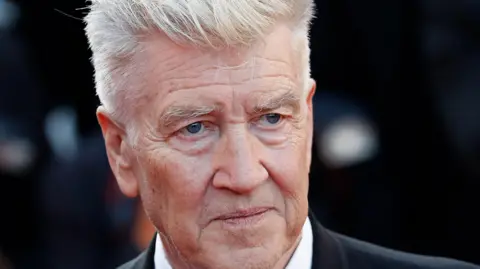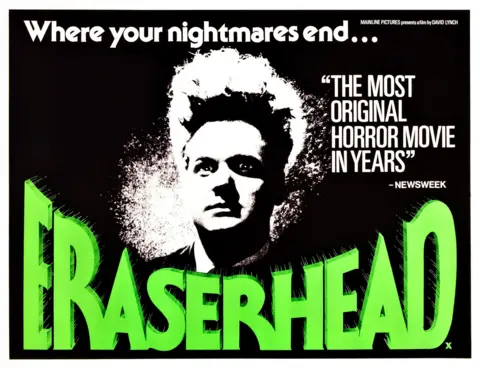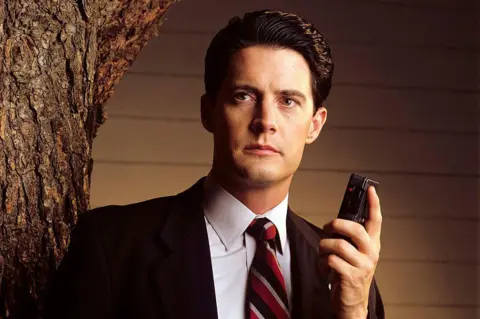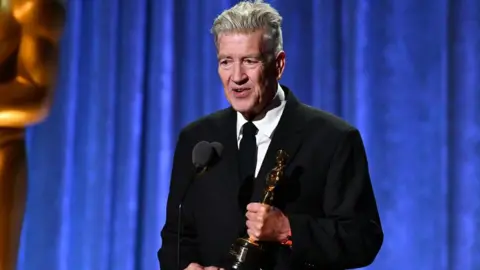 Getty Images
Getty ImagesDavid Lynch once said he was inspired to become a filmmaker when, while painting, he inexplicably heard a gust of wind and saw the artwork move on canvas.
The moment defined his obsession with “seeing paintings move”, but also his flair for the bizarre – twisting realities on the small and big screen for almost 40 years.
The 78-year-old US director, who has died months after announcing an emphysema diagnosis, became the contemporary face of weird, unsettling worlds often hidden within everyday society – from TV series Twin Peaks to films like Blue Velvet, Mulholland Drive and Inland Empire.
A self-professed daydreamer, Lynch burst onto the scene via the midnight movie circuit with 1977’s Eraserhead. The disorientating horror, a comment on male paranoia, set the layered template that ran through his work.
Four decades later, he lived to see his style immortalised as an adjective in the Oxford dictionary. Lynchian, it reads, blurs “surreal or sinister elements with the mundane” – an accolade fitting of the four-time Oscar nominee turned lifetime achievement recipient, whose character was as big as his films.
 Getty Images
Getty ImagesDavid Keith Lynch was born in Missoula, Montana on January 20, 1946. The son of a research scientist for the Department of Agriculture, he spent much of his early life moving around from state to state with his brother and sister.
However, Lynch’s parents encouraged his artistic ambitions from an early age. Speaking to Rolling Stone in 1990, he said his mother “saved” him by encouraging him to draw on scrap paper rather than using colouring books, where “the whole idea is to stay between the lines”.
This ethos inspired his films, tinged by a rebellious streak which he teased lasted from the age of 14 to 30. “People rebel that long these days”, he reasoned, “because we’re built to live longer”.
Youthful frustration at the calm of suburban life left him craving for “something out of the ordinary to happen” to challenge the superficiality of 1950s family ideals – a dark dream his films and shows brought to life.
Lynch’s black-and-white debut feature Eraserhead achieved this vision far more successfully than his years at art school, with its central character descending into madness after fathering a terrifying baby.
 Getty Images
Getty ImagesCritics were left confused, but its late-night cinema success sparked a breakthrough when one audience member recommended him to Mel Brooks, who asked him to helm Elephant Man.
Co-written by Lynch, the film’s cast of eventual screen icons, including John Hurt as Merrick and Anthony Hopkins, transformed the story of stigma into an emotional, critical hit, outpacing the original stage play.
It saw Lynch receive Oscar nominations for best director and adapted screenplay, as part of the film’s eight nominations that included best picture.
But if Hollywood thought it had found a new blockbuster master, Tinseltown quickly discovered Lynch had no interest in playing mainstream with his 1984 adaptation of sci-fi epic Dune.
Featuring questionable special effects, costumes and rock star Sting lathered in baby oil, the Guardian’s Charles Bramesco wrote that Lynch’s experiments left the franchise “radioactive for decades”. “I’m proud of everything except Dune,” Lynch would later tell a YouTube Q&A, while admitting elsewhere it almost “killed” his career.
Coffee, cherry pie… and Twin Peaks
The wounds began to heal, however, when he returned to double down on his signature style – placing his fascination with America’s dirty underbelly in his sights.
Blue Velvet, starring Kyle MacLachlan from Dune, followed a small-town boy caught up in the underworld after he discovered a severed ear. Brutal and violent in part, it divided critics but won Lynch his second Oscar nod for best director.
“This is the way America is to me,” Lynch would later describe the movie in his book Lynch on Lynch. “There’s a very innocent, naive quality to life, and there’s a horror and a sickness as well”.
He won the prestigious Palme d’Or at the Cannes film festival for romance Wild at Heart in 1990, starring Nicolas Cage, Laura Dern and Willem Dafoe.
But it was Lynch’s belief in American beauty and horror being two sides of the same coin, perfected in his TV project Twin Peaks released the same year, that came to define him.
 Getty Images
Getty ImagesOn paper, the unsettling drama explored the murky goings-on in the US logging town following the murder of teenage beauty queen Laura Palmer, hauntingly brought to life by Sheryl Lee.
But viewers were truly captivated by what it offered onscreen: a dreamlike nightmare of wonderfully idiosyncratic characters, including FBI agent Dale Cooper, again played by Kyle MacLachlan, in the apparent comfort of picket-fenced America – cherry pie and coffee included – before unflinchingly reaching into living rooms with its chilling undercurrent of sexual abuse and murder. It was one that had no prior place on US TV.
The ABC show won three Golden Globe awards in 1991, including best TV drama series and best actor in a TV drama for MacLachlan.
“Without Twin Peaks, and its big-bang expansion of the possibilities of television, half your favourite shows wouldn’t exist,” wrote James Parker for The Atlantic.
The show, he continued, “effectively renegotiated TV’s contract with its audience”.
 Getty Images
Getty ImagesIt mattered little that the second season faltered after the killer was revealed. TV was no longer safe, it was viscerally alive – big screen ideas and production values somehow beamed into living rooms in an age when the silver screen still ruled.
In 1992, viewers were taken back to Twin Peaks with a prequel feature film, Fire Walk With Me, but nothing quite matched the original run.
When the nation asked “Who killed Laura Palmer?”, it wasn’t just about solving the mystery, but finding sanctuary from rotten realities society would rather ignore. Lynch had found his darkness.
 Getty Images
Getty ImagesHe would eventually shift focus back to the big screen to attack Hollywood’s devilish tricks of fame, glamour, deceit and identity loss, in films unofficially known as his Los Angeles trilogy.
This began with 1997’s Lost Highway, before 2001’s Mulholland Drive – perhaps the closest in aesthetic to Twin Peaks.
The psychological drama received critical acclaim, scoring Lynch his third best director Oscar nomination and scooping the best director gong at Cannes. In recent years it has also been recognised for its queer themes, particularly between Naomi Watts’ and Laura Harring’s characters, that challenged traditional Hollywood storytelling of the time.
 Getty Images
Getty ImagesLast came 2006’s Inland Empire, Lynch’s final feature film, which proved as mind-melting as ever – showing Hollywood star culture no mercy.
As Mike Muncer told BBC Arts’ Inside Cinema: “Lynch lures us in with the promise of familiar, traditional genre thrills and mysteries as a safety net, before that weirdness starts to creep in.
“Eventually, the mystery box is opened, revealing the darker, more sinister story that Lynch has actually been telling us all along.”
Cult icon
In his latter years Lynch enjoyed revered cult status. In 2017, he directed Twin Peaks: The Return, a new series set 25 years after the events of the original show, with much of the same cast.
At the same time, the show’s legacy continues to endure, inspiring dramas like True Detective and 2023’s critically acclaimed Playstation survival horror game Alan Wake II.
Away from the camera, Lynch admitted he had sometimes struggled to balance the “tricky business” of fatherhood with his career.
He welcomed four children – Jennifer, Austin, Riley and Lula – with ex-wives Peggy Reavey, Mary Fisk and Mary Sweeney, and estranged wife Emily Stofle.
“I love all my children and we get along great, but in the early years, before you can have a relationship of talking to them, it’s tough,” he told Vulture. “The work is the main thing, and I know I’ve caused suffering because of that. But at the same time I have huge love for the kids.”
 Getty Images
Getty ImagesAlthough Lynch never did return to feature film directing to give himself another shot at an elusive Oscar win, he was granted an honorary lifetime achievement statuette by the Academy in 2019. He also made a cameo in Steven Spielberg’s semi-autobiographical 2022 film, The Fablemans, playing filmmaker John Ford.
His artistic pursuits increasingly diversified toward the end of his life, from his original passion for painting to music. Just last year, he released Cellophane Memories, an album with Chrystabell. This added to his previous work producing music videos for artists like Moby and Nine Inch Nails.
Discussing his emphysema diagnosis last summer, he said he was in “excellent shape” and would “never retire”.
He added the diagnosis was the “price to pay” for his smoking habit, although he didn’t regret the enjoyment it gave him.
But his condition deteriorated within months. In a November interview, with People magazine, Lynch said he needed oxygen to walk.
However his ideas live on, as unique as the way he described thinking of them.
Speaking in conversation with musician Patti Smith for BBC Newsnight in 2014, he said: “I get ideas in fragments. It’s as if in the other room there’s a puzzle – all the pieces are together.
“But in my room, they just flip one piece at a time into me.”





